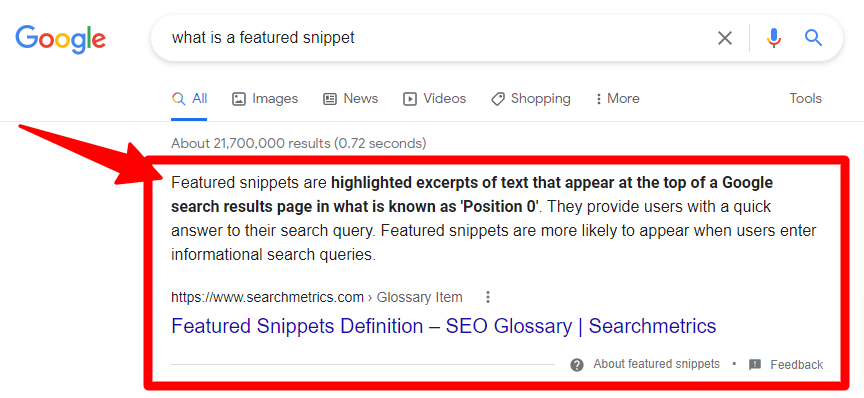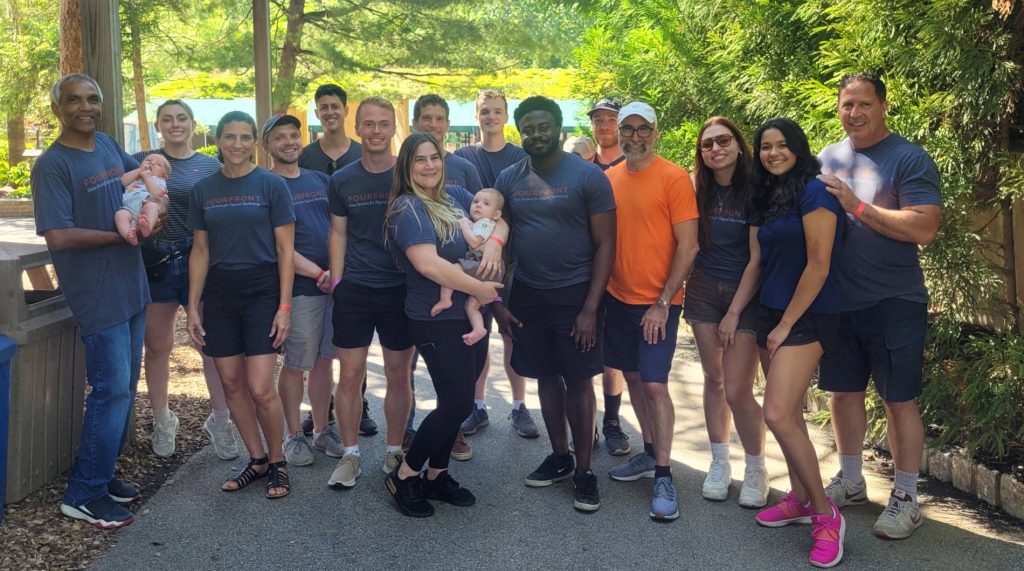Search engine optimization, or SEO, is a powerful digital marketing discipline to attract users searching for your brand’s product or services. And as marketers ought to know, SEO is constantly evolving. To jumpstart your SEO strategy in 2022, it’s important to realize what’s on the horizon – and what to expect in the world of SEO in 2022.
The list below is an aggregate of industry thoughts, analysis of Google actions – as well as our own insights and understandings based on the variety of websites our SEO team works with on a daily basis.
1. The Emergence of GA4
The most impactful development in the SEO world in quite some time is the announcement of Google Analytics 4.
Google Analytics 4, or GA4, is the latest version of Google Analytics. Google first announced Google Analytics 4 in July 2019. Then dubbed “App + Web,” Google Analytics 4 has several unique differences compared to the current installment, Universal Analytics:
- Unifies web + app properties for all-in-one reporting
- Event-based modeling (vs. page-view modeling in Universal Analytics)
- Improved user privacy
- Enhanced machine learning algorithms for additional insights
Anyone currently relying on Universal Analytics will need to quickly bring themselves up to speed on Google Analytics 4. Google recently announced that it will be retiring the current edition of Google Analytics – Universal Analytics – in July 2023. While users will still be able to access the Universal Analytics platform, it will no longer collect data past July 1, 2023.
If you are relying on Universal Analytics for your data collection and reporting, it’s important you start collecting data in Google Analytics 4 (Google – and FourFront! – recommends collection in parallel) as soon as possible to collect essential historical data for performance comparison.
2. Artificial Intelligence
Artificial intelligence is an emerging trend in the SEO industry, and it should be integrated into your SEO strategy for 2022 and beyond.
IBM defines artificial intelligence as “(leveraging) computers and machines to mimic the problem-solving and decision-making capabilities of the human mind.”
For most marketers, that is a lot to unpack. At its core, artificial intelligence is using systems, technology and data to analyze relationships and better understand user behavior.
How will artificial intelligence help SEO strategy, then? Artificial intelligence will help marketers better understand user behavior, and as a result, better market to our target audience.
Artificial intelligence will help us to:
- Identify new trends in user search patterns
- Better understand relationships between different content
- Better understand relationships between different engagement channels (like content and video)
- Better understand user intent
3. Leveraging Predictive Analytics
There are many examples of how predictive analytics are already likely playing a large part in your SEO strategy.
One of the AI-driven platforms SEOs have begun to pay more attention within their content strategies is Google Discover. Google Discover analyzes a user’s engagement history, including what types of sites and content they have previously engaged with – and uses this history to predict future engagement. This future engagement is served as content directly to the user through an automated news feed – without any additional input or need for a user to ever use a keyword or search query.

Google Trends is another powerful tool in the predictive analytics space. We can use historic data points and behavior to identify patterns around trends in interest, seasonality, emerging trends and much more.
We can see the in the chart above that “Mariah Carey” search interest always peaks around the holidays – and provides proof that “All I Want for Christmas” is a holiday classic.
4. Mobile-First Optimization
If you aren’t considering site experience for mobile users – it’s time to start.
Mobile-first optimization is an integral part of any SEO strategy, and it’s here to stay. A Semrush study found that 2/3 of all website visits between 2019 and 2020 came from mobile devices. According to Statista, mobile devices accounted for 63 percent of organic search visits.
And future internet users? CNBC cited research from the World Advertising Research Center that estimated nearly 3 out of every 4 internet users will access the web using only their smartphones by 2025.
But it isn’t just users who are accessing your website on mobile. Starting in July 2019, Google started enabling mobile-first indexing – and in September 2020, mobile-first indexing was to be enabled for all websites. This means Googlebot is using the mobile version of your website – content and all – for indexing and ranking purposes.
Mobile-first optimization includes:
- Ensuring Googlebot can easily crawl your page(s)
- Using the same meta robots tags on desktop and mobile
- Ensuring a high-quality mobile experience (user experience, page speed, etc.)
5. Understanding User Intent
Google is in the business of relevancy. What is a search engine if it’s not able to produce relevant results?
The key piece to remaining relevant: understanding user intent.
User intent is all about researching and understanding the intention of the user as they engage with a search engine or a website. Are they looking for information? Are they looking to learn about a brand or product? Are they looking to buy a product?
Long gone are the days of keyword stuffing and placing keywords on the page to rank. You need to understand what a user is ultimately looking to accomplish and address these patterns on a webpage – and your website as a whole.
SEO is not only about optimizing a webpage – it’s also about optimizing for the user’s experience. Know what your user is ultimately looking to accomplish when engaging with a page, where to lead them next, and ensure it’s a seamless process from start to finish.
6. Collecting First-Party Data
Google has stated that it plans to phase out third-party cookies from its Chrome browser by the end of 2023.
What does this mean to us? First, it’s important to understand what cookies are and what role they play in websites.
Cookies are a small packet of information stored in your browser that help to improve your experience on a website. For example, they can help with:
- Keeping you logged in to a site
- Storing your preferences on a particular site
- Holding your shopping cart items
These types of cookies, ones that enhance your experience on a site, are created by the domain you are visiting and are called first-party cookies.
Third-party cookies are packets of data created by a different domain than the one you are visiting, and are often set for advertising, or for remembering something about the user that can be used for campaigns such as remarketing. Third-party cookies help advertisers target the user with ads that are relevant to the user’s interests. The removal of third-party cookies is driven by a growing demand for user privacy as well as control over how their data is used.
Why does this matter? It effectively means we’ll no longer be able to rely on third-party cookie data to target users. As SEOs, we’ll need to be able to gather our own relevant data using first-party data sources – and get better at making better decisions using the data we’re able to collect.
7. The Rise of Local Search
Local search – and as a result, Local SEO – has been on the rise for several years. Coinciding with the rise of mobile searches, location-based searches (think “near me”-type searches) have also seen a notable increase in recent years. In 2018, Google stated they had seen a 500% growth in “near me” mobile searches – and this was nearly 4 years ago.
This behavior isn’t going away. In fact – if you own a location-based business (whether a one brick-and-mortar location, or you serve customers in a certain area), optimizing for local search will be an essential part of your SEO strategy.
And it isn’t just about ranking in Google Search results. It’s also essential to optimize for Google Maps listings as well – which are often heavily featured in Google Search results.
How do you optimize for local search? Here are just a few things to keep in mind:
- Create (and update) your Google Business Profile account
- Gather strong backlinks via listing sites, local press mentions, etc.
- Generate quality customer reviews
It’s also important to keep in mind that “near me” searches are often times “zero click” searches. Users, often times, will not click through to search results (or listings) – instead relying on information provided by the Google Maps listings to directly connect with businesses (or find the relevant information like address, hours, etc.).
8. Featured Snippets
Ever just want a quick answer, so you jump to Google, do a quick search, and immediately get the answer you’re looking for?
Enter, Featured Snippets.

Featured Snippets are a part of search results that show a “snippet” which summarizes or highlights a webpage that directly answers a user’s search query. According to Google, featured snippets are displayed when “(Google) systems determine this format will help people more easily discover what they’re seeking, both from the description about the page and when they click on the link to read more about the page itself” (Source).
This means that SEOs don’t have a direct influence on whether a Featured Snippet is featured on the SERP – but we can optimize pages to make them more likely to appear as a Featured Snippet. Google is looking for a page that provides an easy-to-discover answer or information pertaining to a user’s keyword. By finding target keywords that produce Featured Snippets and producing content that directly addresses those keywords, such as Frequently Asked Questions, SEOs can better optimize their pages to be included within the Featured Snippet module.
Why do Featured Snippets matter? A TechCrunch study found that 8.6% of clicks go to Featured Snippets, with 19.6% of clicks going to the “first” result in the SERP. However, in SERPs that do not contain a Featured Snippet, the first SERP result typically gets 26% of clicks. This effectively means a nearly 25% decrease in click-through rate for “position 1” search results – all because of the presence of a Featured Snippet.
9. Long-Form Content
As a marketer, you know the saying: content is king. This continues to be just as true today as it was several years ago.
Content – specifically long-form content – still reigns supreme in the SEO world.
A serpIQ study of content length and search results found that the average content length for top organic positions (positions 1-4) typically had a higher word count compared to the rest of page 1 results.

The definition of “long-form content” varies depending on the perspective. Some may consider long-form content to be 1,000+ words, while others may think of long-form content as being 2,500+ or even 3,000+ words.
Long-form content allows you to really “strut your stuff” when it comes to providing users with relevant information. Not only does long-form content really help to show your deep understanding of a given topic, but long-form content also helps ensure you’re covering all aspects of a topic that a user might be interested in learning.
The main thing to consider when drafting long-form content: keep it engaging. Long-form content isn’t just about putting a lot of keywords or content onto a page. The content needs to be relevant, engaging, and consumable. Remember: don’t write for SEO – write for the user.
How can you really boost your SEO efforts for long-form content? Consider the following to keep your long-form content relevant and engaging:
- Break content into well-optimized headers (H2s, H3s, etc.)
- Link to relevant and authoritative sources
- Make sure your content is easily shareable, particularly on social platforms
10. Voice Search
Voice search is another up-and-coming trend in SEO. Thanks to smart home programs like Amazon’s Alexa and Apple’s Siri, most homes are equipped with voice-activated products that are prime targets for casual search engine queries. eMarketer estimated that nearly 40% of internet users would use a voice assistant in 2019 – and with the wide range of voice-activated products on the market, it’s reasonable to assume that number has since grown in 2022.
Pro tip: because voice search is more inclined to be “natural” than typical keywords, you’ll want to focus on long-tail phrases people use in everyday conversation. For example, “how long is the new spider man movie” as opposed to “spider man no way home run time.”
Write your content accordingly as well. Ensure your content uses natural-sounding phrasing that is more “conversational” and less focused on specific keywords.
11. Image Optimization
Image optimization isn’t typically thought of as an SEO “trend” – but it’s important enough that it warrants its own callout in 2022. Visuals and images – particularly for e-commerce websites – are an integral part of the website experience. It allows users to not only learn more about a brand’s product or services – but it allows them to see, interact and engage as well.
It’s also worth noting with the rise of mobile-first indexing, image optimization is becoming even more prevalent. A Semrush study found that images appeared 12.5 times more often in mobile SERPs than on desktop SERPs. If you aren’t already thinking about image optimization – it’s time to start.
Common image optimization techniques include:
- Using high-quality and relevant images
- Using a customized file name
- Using alt tags to allow search engines to understand your images better
- Adding images to sitemaps
For more on image optimization, check out our Image Optimization for SEO blog.
12. SEO for Videos
Although not traditionally thought of as a search engine, YouTube is one of the world’s largest search engines. According to Hootsuite, YouTube is the world’s second-most visited website, trailing only Google.
And it’s not just YouTube when it comes to videos on the internet. Hootsuite also reports that 92% of internet users watch video content on the internet each week.
Video content consumption is certainly on the rise and adds yet another outlet to the traditional thinking of “content is king.” It’s important to have a well-rounded SEO strategy in 2022, and video is quickly becoming an integral part of that well-rounded strategy.
Video content – whether you’re using YouTube or another hosting platform – should be optimized for search. You’ll want to make sure you’re covering the basics, including:
- Optimizing your video channel name and description
- Performing keyword research for specific video-based search engines like YouTube
- Creating and using engaging video content to supplement other web content
- Using relevant video schema markup
13. Prioritizing Data and Analytics
As marketers, we have an increasingly large amount of data at our fingertips in 2022. It’s about how we leverage that data in our decision-making that sets apart a mediocre strategy from a great one.
It’s important to be able to identify the relevant data and analytics that will inform your strategies.
- Working on improving the indexation of your website? Log files are a great data source to understand how Googlebot is crawling and indexing pages.
- Interested in moving a call-to-action higher up on a page? Utilize an A/B testing platform like Google Optimize to test your hypothesis.
At FourFront, we strive to use data that better informs the decision-making and strategies we provide for our clients. From content strategy to technical SEO to competitor analysis, we aim to collect relevant data points and analytics to make sure our decisions and recommendations are supported and well-informed.









